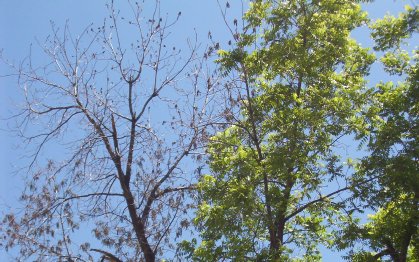AgEBB-MU CAFNR Extension
Green Horizons
Volume 20, Number 1
January 2016
Watching Our Trees Die: "EAB is Here Now - Are We Prepared for TCD?"By Bob Ball, Woodland Landowner, Ohio
A close friend, John, works for the Army Corps of Engineers at Alum Creek Lake north of Columbus, Ohio. He kept telling me about the devastation to ash trees caused by Emerald Ash Borer (EAB) in their 1,200 acres of park land. All of their mature ash trees at Alum Creek are now dead! Central Ohio counties have been infected with EAB for some time, but when John first started describing the damages they were seeing, my tree farm in southeast Ohio was EAB free. Or so I thought until the day John came to visit.
 |
We were looking out over our pasture fields with stands of hardwood timber in the background when John pointed to a single ash tree left to provide shade for the cattle in one of our fields. "I thought you said you didn't have EAB down here," he said. It didn't take him long to convince me many of my ash trees were either dead or dying from emerald ash borer. His visit was only a year ago. Today, I would estimate we've lost 80% of our mature ash trees. It may seem like an insignificant loss to woodland owners here in Missouri, but in Ohio, we have a good market for this species thanks to Ames who buy much of the ash for making tool handles. Also, Amish craftsmen make some amazing furniture pieces with ash. For us, our ash trees are a source of timber income we hate to lose.
It's painful watching your trees die. Our home is located where we can view many acres of our hardwood timber. Every year I notice more and more dead or dying trees. Visitors who drive down our lane past our "Tree Farm" and "Walnut Council" signs have asked "why are your trees dying?" A local logging contractor looking for firewood sources for his thriving firewood business is now cutting these ash trees for his nearby clients and we benefit by improving the attractiveness of our woods. It is important that the wood only be used locally to avoid the spread of EAB!
I know the woodland landowners in Missouri share the same appreciation for their trees as my wife and I do for our Ohio trees. But, I am concerned that they may not be able to visualize how different our Missouri forests might look without black walnut if Thousand Cankers Disease (TCD) should ever become established here. The devastation and economic loss to landowners and the state's rural economy from the spread of TCD over time across the wooded landscape would be shocking. Remember, EAB already has a foothold in selected Missouri counties. How will everyone react and what will be the impacts if TCD should ever be discovered here as well?
